3 How to examine a sick person
3 How to examine a sick person
3 How to examine a sick person
You also want an ePaper? Increase the reach of your titles
YUMPU automatically turns print PDFs into web optimized ePapers that Google loves.
To find out the needs of a <strong>sick</strong> <strong>person</strong>, first you must ask important questions and<br />
then <strong>examine</strong> him carefully. You should look for signs and symp<strong>to</strong>ms that help you tell<br />
how ill the <strong>person</strong> is and what kind of <strong>sick</strong>ness he may have.<br />
Always <strong>examine</strong> the <strong>person</strong> where there is good light, preferably in the sunlight —<br />
never in a dark room.<br />
There are certain basic things <strong>to</strong> ask and <strong>to</strong> look for in anyone who is <strong>sick</strong>. These<br />
include things the <strong>sick</strong> <strong>person</strong> feels or reports (symp<strong>to</strong>ms), as well as things you<br />
notice on examining him (signs). These signs can be especially important in babies<br />
and <strong>person</strong>s unable <strong>to</strong> talk. In this book the word ‘signs’ is used for both symp<strong>to</strong>ms<br />
and signs.<br />
When you <strong>examine</strong> a <strong>sick</strong> <strong>person</strong>, write down your findings and keep them<br />
for the health worker in case he is needed (see p. 44).<br />
QUESTIONS<br />
<strong>How</strong> <strong>to</strong> Examine<br />
a Sick Person<br />
Start by asking the <strong>person</strong> about her<br />
<strong>sick</strong>ness. Be sure <strong>to</strong> ask the following:<br />
What bothers you most right now?<br />
What makes you feel better or<br />
worse?<br />
<strong>How</strong> and when did your <strong>sick</strong>ness<br />
begin?<br />
Have you had this same trouble<br />
before, or has anyone else in<br />
your family or neighborhood<br />
had it?<br />
Continue with other questions<br />
in order <strong>to</strong> learn the details of the illness.<br />
For example, if the <strong>sick</strong> <strong>person</strong> has a pain, ask her:<br />
Where does it hurt? (Ask her <strong>to</strong> point <strong>to</strong> the exact place with one finger.)<br />
Does it hurt all the time, or off and on?<br />
What is the pain like? (sharp? dull? burning?)<br />
Can you sleep with the pain?<br />
CHAPTER<br />
3<br />
If the <strong>sick</strong> <strong>person</strong> is a baby who still does not talk, look for signs of pain. Notice<br />
his movements and how he cries. (For example, a child with an earache sometimes<br />
rubs the side of his head or pulls at his ear.)<br />
29
30<br />
Where There Is No Doc<strong>to</strong>r 2011<br />
GENERAL CONDITION OF HEALTH<br />
Before <strong>to</strong>uching the <strong>sick</strong> <strong>person</strong>, look at him carefully. Observe how ill or weak he<br />
looks, the way he moves, how he breathes, and how clear his mind seems. Look for<br />
signs of dehydration (see p. 151) and of shock (p. 77).<br />
Notice whether the <strong>person</strong> looks well nourished or poorly nourished. Has he been<br />
losing weight? When a <strong>person</strong> has lost weight slowly over a long period of time, he may<br />
have a chronic illness (one that lasts a long time).<br />
Also note the color of the skin and eyes. These sometimes change when a <strong>person</strong><br />
is <strong>sick</strong>. (Dark skin can hide color changes. So look at parts of the body where the skin<br />
is pale, such as palms of the hands or soles of the feet, the fingernails, or the insides of<br />
the lips and eyelids.)<br />
• Paleness, especially of the lips and inside the eyelids, is a sign of anemia<br />
(p. 124). Skin may also go lighter as a result of tuberculosis (p. 179), or<br />
kwashiorkor (p. 113).<br />
• Darkening of the skin may be a sign of starvation (see p. 112).<br />
• Bluish skin, especially blueness or darkness of the lips and fingernails, may<br />
mean serious problems with breathing (p. 79, 167, and 313) or with the heart (p.<br />
325). Blue-gray color in an unconscious child may be a sign of cerebral malaria<br />
(p. 186).<br />
• A gray-white coloring, with cool moist skin, often means a <strong>person</strong> is in shock<br />
(p. 77).<br />
• Yellow color (jaundice) of the skin and eyes may result from disease in the liver<br />
(hepatitis, p. 172, cirrhosis, p. 328, or amebic abscess, p. 145) or gallbladder<br />
(p. 329). It may also occur in newborn babies (p. 274), and in children born with<br />
<strong>sick</strong>le cell disease (p. 321).<br />
Look also at the skin when a light is shining across it from one side. This can show<br />
the earliest sign of measles rash on the face of a feverish child (p. 311).<br />
TEMPERATURE<br />
It is often wise <strong>to</strong> take a <strong>sick</strong> <strong>person</strong>’s temperature, even if he<br />
does not seem <strong>to</strong> have a fever. If the <strong>person</strong> is very <strong>sick</strong>, take the<br />
temperature at least 4 times each day and write it down.<br />
If there is no thermometer, you can get an idea of the<br />
temperature by putting the back of one hand on the<br />
<strong>sick</strong> <strong>person</strong>’s forehead and the other on your own or<br />
that of another healthy <strong>person</strong>. If the <strong>sick</strong> <strong>person</strong> has<br />
a fever, you should feel the difference.<br />
It is important <strong>to</strong> find out when and how the fever comes, how long it lasts, and how<br />
it goes away. This may help you identify the disease. Not every fever is malaria, though<br />
in some countries it is often treated as such. Remember other possible causes. For<br />
example:<br />
• Common cold, and other virus infections (p. 163). The fever is usually mild.<br />
• Typhoid causes a fever that goes on rising for 5 days. Malaria medicine does not<br />
help.<br />
• Tuberculosis sometimes causes a mild fever in the afternoon. At night the <strong>person</strong><br />
often sweats, and the fever goes down.
<strong>How</strong> <strong>to</strong> Use a Thermometer<br />
Every family should have a thermometer. Take the temperature of a <strong>sick</strong> <strong>person</strong><br />
4 times a day and always write it down.<br />
<strong>How</strong> <strong>to</strong> read the thermometer (using one marked in degrees centigrade—°C):<br />
Turn the thermometer until you<br />
can see the silver line.<br />
Normal<br />
The point where the silver line<br />
s<strong>to</strong>ps marks the temperature.<br />
<strong>How</strong> <strong>to</strong> take the temperature:<br />
1. Clean the thermometer well with<br />
soap and water or alcohol. Shake<br />
it hard, with a snap of the wrist,<br />
until it reads less than 36 degrees.<br />
2. Put the thermometer…<br />
under the <strong>to</strong>ngue<br />
(keeping the<br />
mouth shut)<br />
Fever<br />
or<br />
in the armpit if there<br />
is danger of biting<br />
the thermometer<br />
or<br />
3. Leave it there for 3 or 4 minutes.<br />
High Fever<br />
This thermometer<br />
marks 40 degrees C.<br />
carefully, in the anus<br />
of a small child<br />
(wet or grease it first)<br />
4. Read it. (An armpit temperature will read a little lower than a mouth reading;<br />
in the anus it will read a little higher.)<br />
5. Wash the thermometer well with soap and water.<br />
Where There Is No Doc<strong>to</strong>r 2011<br />
Note: in newborn babies a temperature that is unusually high or unsually low<br />
(below 36°) may mean a serious infection (see p. 275).<br />
♦ To learn about other fever patterns, see p. 26 <strong>to</strong> 27.<br />
♦ To learn what <strong>to</strong> do for a fever, see p. 75.<br />
31
32<br />
Where There Is No Doc<strong>to</strong>r 2011<br />
BREATHING (RESPIRATION)<br />
Pay special attention <strong>to</strong> the way the <strong>sick</strong> <strong>person</strong> breathes—the depth (deep or<br />
shallow), rate (how often breaths are taken), and difficulty. Notice if both sides of the<br />
chest move equally when she breathes.<br />
If you have a watch or simple timer, count the number of breaths per minute (when<br />
the <strong>person</strong> is quiet). Between 12 and 20 breaths per minute is normal for adults and<br />
older children. Up <strong>to</strong> 30 breaths a minute is normal for younger children, and 40 for<br />
babies. People with a high fever or serious respira<strong>to</strong>ry illness breathe more quickly than<br />
normal. For example, more than 30 shallow breaths a minute in an adult usually means<br />
pneumonia, as does 60 breaths a minute for a newborn baby.<br />
Listen carefully <strong>to</strong> the sound of the breaths. For example:<br />
• A whistle or wheeze and difficulty breathing out can mean asthma (see p. 167).<br />
• A gurgling or snoring noise and difficult breathing in an unconscious <strong>person</strong><br />
may mean the <strong>to</strong>ngue, mucus (slime or pus), or something else is stuck in the<br />
throat and does not let enough air get through.<br />
Look for ‘sucking in’ of the skin between ribs and at the angle of the neck (behind<br />
the collar bone) when the <strong>person</strong> breathes in. This means air has trouble getting<br />
through. Consider the possibility of something stuck in the throat (p. 79), pneumonia<br />
(p. 171), asthma (p. 167), or bronchitis (mild sucking in, see p. 170).<br />
If the <strong>person</strong> has a cough, ask if it keeps her from sleeping. Find out if she coughs<br />
up mucus, how much, its color, and if there is blood in it.<br />
Pay attention <strong>to</strong> the strength, the rate, and the regularity of the pulse. If you have a<br />
watch or timer, count the pulses per minute.<br />
PULSE (HEARTBEAT)<br />
To take the <strong>person</strong>’s pulse,<br />
put your fingers on the wrist<br />
as shown. (Do not use your<br />
thumb <strong>to</strong> feel for the pulse.)<br />
If you cannot find the pulse in<br />
the wrist, feel for it in the neck<br />
beside the voicebox.<br />
NORMAL PULSE FOR PEOPLE AT REST<br />
adults . . . . . . . . from 60 <strong>to</strong> 80 per minute<br />
children . . . . . . .80 <strong>to</strong> 100<br />
babies . . . . . . . .100 <strong>to</strong> 140<br />
Or put your ear directly or<br />
the chest and listen for the<br />
heartbeat (or use a stethoscope<br />
if you have one).
The pulse gets much faster with exercise and when a <strong>person</strong> is nervous,<br />
frightened, or has a fever. As a general rule, the pulse increases 20 beats per minute<br />
for each degree (°C) rise in fever.<br />
When a <strong>person</strong> is very ill, take the pulse often and write it down along with the<br />
temperature and rate of breathing.<br />
It is important <strong>to</strong> notice changes in the pulse rate. For example:<br />
• A weak, rapid pulse can mean a state of shock (see p. 77).<br />
• A very rapid, very slow, or irregular pulse could mean heart trouble<br />
(see p. 325).<br />
• A relatively slow pulse in a <strong>person</strong> with a high fever may be a sign of typhoid<br />
(see p. 188).<br />
EYES<br />
Where There Is No Doc<strong>to</strong>r 2011<br />
Look at the color of the white part of the eyes. Is it normal, red (p. 219), or yellow?<br />
Also note any changes in the <strong>sick</strong> <strong>person</strong>’s vision.<br />
Have the <strong>person</strong> slowly move her eyes up and down and from side <strong>to</strong> side.<br />
Jerking or uneven movement may be a sign of brain damage.<br />
Pay attention <strong>to</strong> the size and color of the pupils (the black ‘window’ in the center<br />
of the eye). If they are very large, it can mean a state of shock (see p. 77). If they are<br />
very large, or very small, it can mean poison or the effect of certain drugs. If there is<br />
a white glow, it can mean cataracts (see p. 225) or cancer.<br />
Look at both eyes and note any difference between the two, especially in the size<br />
of the pupils:<br />
A big difference in the size of the pupils is almost always a medical emergency.<br />
• If the eye with the larger pupil hurts so badly it causes vomiting, the <strong>person</strong><br />
probably has GLAUCOMA (see p. 222).<br />
• If the eye with the smaller pupil hurts a great deal, the <strong>person</strong> may have<br />
IRITIS, a very serious problem (see p. 221).<br />
• Difference in the size of the pupils of an unconscious <strong>person</strong> or a <strong>person</strong> who<br />
has had a recent head injury may mean brain damage. It may also mean<br />
STROKE (see p. 327).<br />
Always compare the pupils of a <strong>person</strong> who is unconscious or has had a<br />
head injury.<br />
33
34<br />
Where There Is No Doc<strong>to</strong>r 2011<br />
EARS, THROAT, AND NOSE<br />
Ears: Always check for signs of pain and<br />
infection in the ears-especially in a child with fever<br />
or a cold. A baby who cries a lot or pulls at his ear<br />
often has an ear infection (p. 309).<br />
Pull the ear gently. If this increases pain, the<br />
infection is probably in the tube of the ear (ear<br />
canal). Also look for redness or pus inside the ear.<br />
A small flashlight or penlight will help. But never<br />
put a stick, wire, or other hard object inside the ear.<br />
Find out if the <strong>person</strong> hears well, or if one side is<br />
more deaf than the other. Rub your thumb and fingers <strong>to</strong>gether near the <strong>person</strong>’s ear <strong>to</strong><br />
see if he can hear it. For deafness and ringing of the ears see page 327.<br />
Throat and Mouth: With a <strong>to</strong>rch (flashlight) or sunlight <strong>examine</strong> the mouth and<br />
throat. To do this hold down <strong>to</strong>ngue with a spoon handle or have the <strong>person</strong> say<br />
‘ahhhhh...’ Notice if the throat is red and if the <strong>to</strong>nsils (2 lumps at the back of the throat)<br />
are swollen or have spots with pus (see p. 309). Also <strong>examine</strong> the mouth for sores,<br />
inflamed gums, sore <strong>to</strong>ngue, rotten or abscessed teeth and other problems. (Read<br />
Chapter 17.)<br />
Nose: Is the nose runny or plugged? (Notice if and how a baby breathes through<br />
his nose.) Shine a light inside and look for mucus, pus, blood; also look for redness,<br />
swelling, or bad smell. Check for signs of sinus trouble or hayfever (p. 165).<br />
SKIN<br />
It is important <strong>to</strong> <strong>examine</strong> the <strong>sick</strong> <strong>person</strong>’s whole body, no matter how mild the<br />
<strong>sick</strong>ness may seem. Babies and children should be undressed completely. Look<br />
carefully for anything that is not normal, including:<br />
• sores, wounds, or splinters<br />
• rashes or welts<br />
• spots, patches, or any unusual markings<br />
• inflammation (sign of infection with<br />
redness, heat, pain and swelling)<br />
• swelling or puffiness<br />
• swollen lymph nodes (little lumps in the<br />
neck, the armpits, or the groin, see p. 88)<br />
Always <strong>examine</strong> little children between the<br />
but<strong>to</strong>cks, in the genital area, between the fingers<br />
and <strong>to</strong>es, behind the ears, and in the hair (for<br />
lice, scabies, ringworm, rashes, and sores).<br />
For identification of different skin<br />
problems, see pages 196 -198.<br />
• abnormal lumps or masses<br />
• unusual thinning or loss of hair, or<br />
loss of its color or shine (p. 112)<br />
• loss of eyebrows<br />
(leprosy? p. 191)
THE BELLY (ABDOMEN)<br />
If a <strong>person</strong> has pain in the belly, try <strong>to</strong> find out exactly where it hurts.<br />
Learn whether the pain is steady or whether it suddenly comes and goes, like<br />
cramps or colic.<br />
When you <strong>examine</strong> the belly, first look at it for any unusual swelling or lumps.<br />
The location of the pain often gives a clue <strong>to</strong> the cause (see the following page).<br />
First, ask the <strong>person</strong> <strong>to</strong><br />
point with one finger<br />
where it hurts.<br />
Where There Is No Doc<strong>to</strong>r 2011<br />
Then, beginning on the opposite side from the spot<br />
where he has pointed, press gently on different<br />
parts of the belly <strong>to</strong> see where it hurts most.<br />
See if the belly is soft or hard and whether the <strong>person</strong> can relax his s<strong>to</strong>mach<br />
muscles. A very hard belly could mean an acute abdomen—perhaps appendicitis or<br />
peri<strong>to</strong>nitis (see p. 94).<br />
If you suspect peri<strong>to</strong>nitis or appendicitis, do the test for rebound pain described<br />
on page 95.<br />
Feel for any abnormal lumps and hardened areas in the belly.<br />
If the <strong>person</strong> has a constant pain in the s<strong>to</strong>mach, with nausea, and has not been<br />
able <strong>to</strong> move her bowels, put an ear (or stethoscope) on the belly, like this:<br />
A silent belly is like a silent dog. Beware!<br />
Listen for gurgles in the<br />
intestines. If you hear nothing<br />
after about 2 minutes, this is a<br />
danger sign. (See Emergency<br />
Problems of the Gut, p. 93.)<br />
35
36<br />
Where There Is No Doc<strong>to</strong>r 2011<br />
These pictures show the areas of the belly that usually hurt when a <strong>person</strong> has the<br />
following problems:<br />
Ulcer<br />
(see p. 128)<br />
pain in the<br />
‘pit of the<br />
s<strong>to</strong>mach’<br />
Gallbladder<br />
(see p. 329)<br />
the pain<br />
often reaches<br />
<strong>to</strong> the back<br />
Urinary system<br />
(see p. 234)<br />
mid or low back<br />
pain, often goes<br />
around the waist<br />
<strong>to</strong> the lower part<br />
of the belly<br />
urinary<br />
tubes<br />
bladder<br />
Note: For different causes of back pain see p. 173.<br />
Appendicitis<br />
(see p. 94)<br />
first it<br />
hurts here<br />
later it<br />
hurts here<br />
Liver<br />
(see p. 172, 144,<br />
and 328)<br />
pain here,<br />
at times it<br />
spreads <strong>to</strong><br />
the chest<br />
Inflammation or<br />
tumor of the ovaries,<br />
or out-of-place<br />
pregnancy<br />
(see p. 280)<br />
pain on one<br />
side or both,<br />
sometimes<br />
spreading <strong>to</strong><br />
the back
MUSCLES AND NERVES<br />
If a <strong>person</strong> complains of numbness, weakness, or loss of control in part of his<br />
body, or you want <strong>to</strong> test it: notice the way he walks and moves. Have him stand, sit,<br />
or lie completely straight, and carefully compare both sides of his body.<br />
Face: Have him smile, frown, open his eyes wide, and squeeze<br />
them shut. Notice any drooping or weakness on one side.<br />
If the problem began more or less suddenly, think of a head<br />
injury (p. 91), stroke (p. 327), or Bell’s palsy (p. 327).<br />
If it came slowly, it may be a brain tumor. Get medical advice.<br />
Also check for normal eye movement, size of pupils (p. 217),<br />
and how well he can see.<br />
Arms and legs: Look for loss of muscle. Notice—or measure—<br />
difference in thickness of arms or legs.<br />
Watch how he moves and walks. If muscle loss or weakness affects the whole<br />
body, suspect malnutrition (p. 112) or a chronic (long-term) illness like tuberculosis.<br />
Have him squeeze your<br />
fingers <strong>to</strong> compare strength<br />
in his hands<br />
Also have him hold his arms straight<br />
out and turn his hands up and down.<br />
and push and pull with his<br />
feet against your hand.<br />
Where There Is No Doc<strong>to</strong>r 2011<br />
Note any<br />
weakness or<br />
trembling.<br />
Have him lie down and lift one leg<br />
and then the other.<br />
Any string or<br />
ribbon will do<br />
<strong>to</strong> check if the<br />
distance around<br />
the arms or legs<br />
is different.<br />
If muscle loss and weakness is uneven or worse on one side, in children, think<br />
first of polio (p. 314); in adults, think of a back problem, a back or head injury, or<br />
stroke.<br />
For more information on muscle testing and physical examination of disabled<br />
<strong>person</strong>s, see Disabled Village Children, Chapter 4.<br />
37
38<br />
Where There Is No Doc<strong>to</strong>r 2011<br />
Check for stiffness or tightness of different muscles:<br />
• If the jaw is stiff or will not open, suspect tetanus (p. 182) or a<br />
severe infection of the throat (p. 309) or of a <strong>to</strong>oth (p. 231). If the<br />
problem began after he yawned or was hit in the jaw, he may<br />
have a dislocated jaw.<br />
• If the neck or back is stiff and bent<br />
backwards, in a very <strong>sick</strong> child, suspect<br />
meningitis. If the head will not bend forward<br />
or cannot be put between the knees,<br />
meningitis is likely (p. 185).<br />
meningitis<br />
• If a child always has some stiff muscles and<br />
makes strange or jerky movements, he may be spastic (p. 320).<br />
• If strange or jerky movements come suddenly, with loss of consciousness, he may<br />
have seizures (p. 178). If seizures<br />
happen often, think of epilepsy.<br />
If they happen when he is ill, the<br />
cause may be high fever (p. 76)<br />
or dehydration (p. 151) or tetanus<br />
tetanus<br />
(p. 182) or meningitis (p. 185).<br />
To test a <strong>person</strong>’s reflexes when you suspect tetanus, see p. 183.<br />
To check for loss of feeling in the hands, feet, or other parts of the body:<br />
Have the <strong>person</strong> cover his eyes. Lightly <strong>to</strong>uch<br />
or prick the skin in different places. Ask him <strong>to</strong><br />
say ‘yes’ when he feels it.<br />
• Loss of feeling in or near spots or patches<br />
on the body is probably leprosy (p. 191).<br />
• Loss of feeling in both hands or feet<br />
may be due <strong>to</strong> diabetes (p. 127)<br />
or leprosy.<br />
• Loss of feeling on one side only<br />
could come from a back problem<br />
(p. 174) or injury.




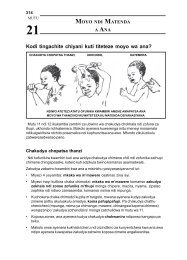
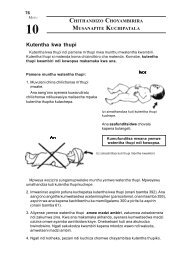
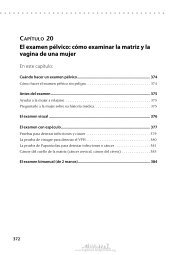
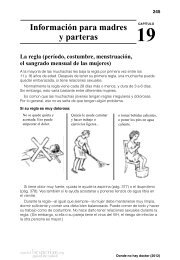
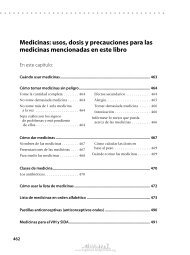
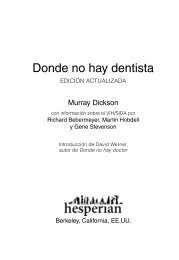
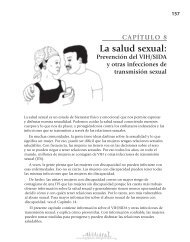
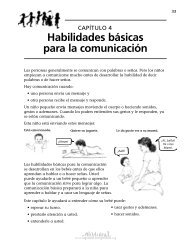


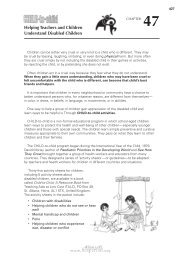
![kl/jf/ lgof]hg](https://img.yumpu.com/10041849/1/184x260/kl-jf-lgofhg.jpg?quality=85)
